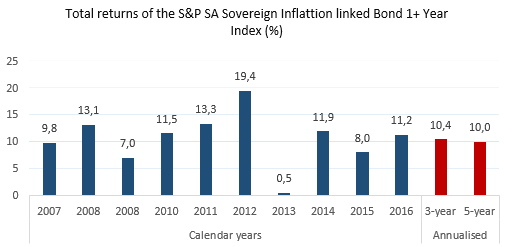Intellidex reviews: Satrix ILBI ETF

ETF ANALYSIS
Satrix ILBI ETF
The Satrix Ilbi is a new addition to SA’s ETF market, showing that it continues to gain momentum. Three new funds have been launched so far this year. This is the second from Satrix, which also listed the Satrix Property ETF earlier this month, and they followed the US Dollar Custodial Certificates ETF launched by RMB earlier this year.The slight disappointment though is that the Satrix Ilbi is not going to offer anything different from currently available inflation-linked bond ETFs. It will be tracking SA’s government inflation-linked bonds in almost the same manner as existing ETFs offered by Asburton and Absa. But it is likely to be cheaper: it’s expected to have a total expense ratio (TER) of 0.25% which, if maintained, will be far cheaper than its peers, which have ratios above 0.4%. This can make a significant difference to one’s portfolio over the long term.
Suitability
This is a medium-risk fund that aims to deliver income and capital growth over the medium term. It’s a suitable addition to a portfolio which has a medium to long-term investment horizon. While most investors typically use bond ETFs in income strategies, this fund might not suit such a strategy – the Satrix Ilbi is a total return index so it doesn’t pay any cash dividend. Monthly coupons received are reinvested into the fund to increase the net asset value of the portfolio and consequently increase the value of each unit. RMB’s Inflation-X ETF is the only bond ETF which pays dividends.
What it does
Satrix Ilbi aims to track the performance of the S&P South Africa Sovereign Inflation-Linked Bond 1+ Year Index. That’s quite a mouthful, but it’s an index, weighted by market value, that tracks the performance of rand-denominated inflation-linked securities issued by the government for the domestic market.
Advantages
The main attraction of bonds as an asset class within an investment portfolio is their low correlation with stocks. Over the past decade, the JSE’s all bond index has had a lowly correlation factor of 0.13 with the all share index. This diversification is important: bonds act to stabilise portfolios when the equities component is underperforming. And because the ETF is inflation-protected, the initial amount invested will increase in line with inflation.
Disadvantages
The fund does not make active bets relative to sectors, yield curve or credit quality. It is also restricted to certain government bonds, thus excluding corporate bonds and other issues by state-owned institutions such as Eskom and Sanral, which have higher yields.
Top holdings
The fund is invested in bonds issued by the SA government with the majority being long-term bonds with maturities of seven years or more.
Risk
The most common risks associated with fixed-income securities are inflation risk, credit risk and interest rate risk. With the underlying index having a duration – which is a measure of the sensitivity of bonds to changes in interest rate – of about 12 years, interest rate risk should be a major consideration for this ETF. However, because all this ETF’s constituents are inflation-linked sovereign bonds issued by the SA government, they do not have inflation risk and credit risk is minimal.

Fees
Satrix ILBI ETF is expected to have a (TER) of 0.25%.
Historical performance
The fund has no historical record, so below is the performance of its benchmark. It shows that at time, bonds have the potential to outperform equities.

Fundamental view
Government bonds are traditionally seen as safe havens in turbulent times. This is largely because they are less volatile than stocks and their prices often trend in the opposite direction to equities, so they offer good diversification. The past decade has been a superb one to own bonds as shown on the graph above.
The prices of bonds fluctuate, tracking macroeconomic developments, monetary policy and the overall supply and demand on the market. The monetary policy set by the South African Reserve Bank (SARB) has a strong impact on bond performances. A rising repo rate tends to draw money away from bonds, causing the price to drop, while a decline in the repo rate will have the opposite effect. Bonds also tend to drop when other investments seem less risky and the economy is in expansion. During recessions, investors may decide that bonds are the safest place for their money, and demand could spike.

Alternatives
Retail investors seeking exposure to bonds have two other options: Ashburton Inflation ETF and NewFunds Ilbi ETF.
Ashburton Inflation ETF tracks the South African government inflation-linked bond total return index of eight RSA inflation-linked bonds. The product has an expected TER of 0.47% a year.
NewFunds ILBI is also a total return product but tracks the performance of the Barclays\Absa South African government inflation-linked bond index. It has a TER of 0,43% a year.
Background: Exchange traded funds (ETFs)
Exchange Traded Funds (ETFs) are passively managed investment funds that track the performance of a basket of pre-determined assets (in this case, US treasuries). They are traded the same way as shares and the main difference is that whereas one share gives exposure to one company, an ETF gives exposure to more than one company or instrument in a single transaction. ETFs can be traded through your broker the same way as shares, say, on the EasyEquities platform.
Benefits of ETFs
- Gain instant exposure to various underlying shares or bonds in one transaction
- They diversify risk because a single ETF holds various shares
- They are cost-effective
- They are liquid – it is usually easy to find a buyer or seller and they trade just like shares
- High transparency through daily published index constituents
|
Subscribe To Our Research Portal
Search all research
Let Us Help You, Help Yourself
From how-to’s to whos-whos you’ll find a bunch of interesting and helpful stuff in our collection of videos. Our knowledge base is jam packed with answers to all the questions you can think of.
